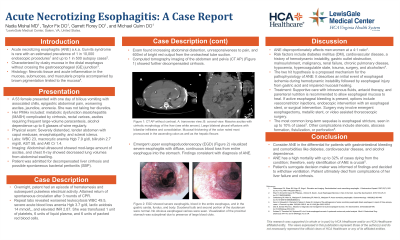Sunday Poster Session
Category: GI Bleeding
P0777 - Acute Necrotizing Esophagitis in a Decompensated Cirrhotic
Sunday, October 27, 2024
3:30 PM - 7:00 PM ET
Location: Exhibit Hall E

Has Audio

Garrett M. Florey, DO
Lewis Gale Medical Center
Salem, VA
Presenting Author(s)
Nadia Mishal, MD1, Taylor M. Fix, DO1, Garrett M. Florey, DO2, Michael Quinn, DO1
1Lewis Gale Medical Center, Salem, VA; 2Lewis Gale Medical Center, Roanoke, VA
Introduction: Acute necrotizing esophagitis (ANE) is a rare diagnosis characterized by black appearing esophageal mucosa1. The two-hit hypothesis is a proposed mechanism for the pathophysiology of ANE, describing an initial event of esophageal ischemia during a low flow state, followed by esophageal injury from gastric acid2. This case report is unique as it occurs in an atypical demographic and with a history of previously normal upper endoscopy findings, but in a patient with significant risk factors. Common risk factors include diabetes mellitus (DM), cardiovascular disease, a history of hemodynamic instability, malnourishment, and alcoholism3.
Case Description/Methods: A 53-year-old female presented for one day of persistent bilious vomiting with associated chills, epigastric abdominal pain, ascites, jaundice, and anorexia. Patient has a significant medical history of metabolic dysfunction associated steatohepatitis (MASH) complicated by cirrhosis, rectal varices, and ascites requiring frequent large volume paracenteses. Patient continues to drink alcohol, up to 5 to 6 glasses of wine every other day. Overnight, patent had an episode of hematemesis and pulselessness. She had return of spontaneous circulation after 3 rounds of cardiopulmonary resuscitation. Labs revealed worsened leukocytosis WBC 49.5, severe acute blood loss anemia Hgb 3.7 g/dl, lactic acidosis 14 mmol/L, and elevated INR 2.87. She received multiple blood transfusions. Emergent upper esophagogastroduodenoscopy (EGD) visualized severe esophagitis with diffuse, continuous blood loss from the .entire esophagus into the stomach. The esophageal mucosa was black-appearing from mid to distal portions and did not extend past the GE junction. The findings were consistent with a diagnosis of ANE.
Discussion: The treatment for ANE includes supportive care with intravenous fluids, antacid therapy, and parenteral nutrition to allow the esophageal mucosa to heal. ANE has a high mortality with up to 32% of cases dying from the condition, therefore early identification of ANE is an important factor in its management2. During discussion of the findings, the surrogate decision maker elected to withdraw ventilation. The patient ultimately died from complications of liver failure.
1Goldenberg SP et al, Acute necrotizing esophagitis, 1990; 98(2):493-496
2Dias E et al, Diagnosis and management of acute esophageal necrosis, 2019;32(6):529-540
3Gurvits GE et al, Acute esophageal necrosis: a rare syndrome, 2007;42(1):29-38
Disclosures:
Nadia Mishal, MD1, Taylor M. Fix, DO1, Garrett M. Florey, DO2, Michael Quinn, DO1. P0777 - Acute Necrotizing Esophagitis in a Decompensated Cirrhotic, ACG 2024 Annual Scientific Meeting Abstracts. Philadelphia, PA: American College of Gastroenterology.
1Lewis Gale Medical Center, Salem, VA; 2Lewis Gale Medical Center, Roanoke, VA
Introduction: Acute necrotizing esophagitis (ANE) is a rare diagnosis characterized by black appearing esophageal mucosa1. The two-hit hypothesis is a proposed mechanism for the pathophysiology of ANE, describing an initial event of esophageal ischemia during a low flow state, followed by esophageal injury from gastric acid2. This case report is unique as it occurs in an atypical demographic and with a history of previously normal upper endoscopy findings, but in a patient with significant risk factors. Common risk factors include diabetes mellitus (DM), cardiovascular disease, a history of hemodynamic instability, malnourishment, and alcoholism3.
Case Description/Methods: A 53-year-old female presented for one day of persistent bilious vomiting with associated chills, epigastric abdominal pain, ascites, jaundice, and anorexia. Patient has a significant medical history of metabolic dysfunction associated steatohepatitis (MASH) complicated by cirrhosis, rectal varices, and ascites requiring frequent large volume paracenteses. Patient continues to drink alcohol, up to 5 to 6 glasses of wine every other day. Overnight, patent had an episode of hematemesis and pulselessness. She had return of spontaneous circulation after 3 rounds of cardiopulmonary resuscitation. Labs revealed worsened leukocytosis WBC 49.5, severe acute blood loss anemia Hgb 3.7 g/dl, lactic acidosis 14 mmol/L, and elevated INR 2.87. She received multiple blood transfusions. Emergent upper esophagogastroduodenoscopy (EGD) visualized severe esophagitis with diffuse, continuous blood loss from the .entire esophagus into the stomach. The esophageal mucosa was black-appearing from mid to distal portions and did not extend past the GE junction. The findings were consistent with a diagnosis of ANE.
Discussion: The treatment for ANE includes supportive care with intravenous fluids, antacid therapy, and parenteral nutrition to allow the esophageal mucosa to heal. ANE has a high mortality with up to 32% of cases dying from the condition, therefore early identification of ANE is an important factor in its management2. During discussion of the findings, the surrogate decision maker elected to withdraw ventilation. The patient ultimately died from complications of liver failure.
1Goldenberg SP et al, Acute necrotizing esophagitis, 1990; 98(2):493-496
2Dias E et al, Diagnosis and management of acute esophageal necrosis, 2019;32(6):529-540
3Gurvits GE et al, Acute esophageal necrosis: a rare syndrome, 2007;42(1):29-38
Disclosures:
Nadia Mishal indicated no relevant financial relationships.
Taylor Fix indicated no relevant financial relationships.
Garrett Florey indicated no relevant financial relationships.
Michael Quinn indicated no relevant financial relationships.
Nadia Mishal, MD1, Taylor M. Fix, DO1, Garrett M. Florey, DO2, Michael Quinn, DO1. P0777 - Acute Necrotizing Esophagitis in a Decompensated Cirrhotic, ACG 2024 Annual Scientific Meeting Abstracts. Philadelphia, PA: American College of Gastroenterology.
